 3-Line, Etc. Material on the iPhone and the iPod touch
3-Line, Etc. Material on the iPhone and the iPod touch
Updated 2018-08-02
Links to Related Pages
Contents
- Introduction
- EPUB Files are Recommended
- Downloading and Opening EPUB Files
- Using EPUB Files in iBooks
- PDF Files and Paper Sizes
- Apps for PDF Files
- Downloading PDF Files
- Orientation and Zooming
- PDF Link Navigation and Annotation
- Sharing PDF Files
Introduction
Rather than just printing out the 3-line, etc. files on paper, people are using them more and more on computers, including mobile devices such as the iPhone, the iPod touch, and the iPad. Doing so saves time, effort, materials, and money. Also, you can do many things with digital publications like the 3-line, etc. files that you cannot do with paper printouts, like
- Have all of them with you everywhere, all the time, on your mobile device so that they’re always at your fingertips and available to be used
- Obtain them if necessary from any place where you have Internet access, any time you need them
- Very quickly find what you want in them, using bookmarks, links, searching, and other navigation aids
- Easily zoom in to get a better look at little Pīnyīn tone marks, or at critical strokes and dots in Chinese characters
- Cleanly and easily add, change, or delete annotations as needed
- Quickly and easily create copies and share them with others
- etc. ...
Since the iPhone and iPod touch are so capable, easy to use, and easy to carry, if you have one of these devices, you probably often have it with you. It is thus desirable to be able to use the 3-line material effectively on them, even though with their relatively small screens they are not as ideal for viewing and using 3-line material on as an iPad is.
The Retina displays of recent generations of the iPhone and the iPod touch are especially good for displaying 3-line material—every Pīnyīn tone mark and every stroke and dot in every Chinese character is crystal clear, even at small text sizes. It has been said that looking at a Retina display is like looking at a physical page of a paper magazine.
EPUB Files are Recommended
When they are available, EPUB files are recommended for use on the iPhone and iPod touch over PDF files. Basically, PDF files are rooted in the print world, whereas EPUB files are native to and thus more at home on computing devices like the iPhone and iPod touch.
For example, with a PDF file, if you pinch out to enlarge the text, some text could get pushed off the right or left edges of your screen, forcing you to scroll right or left to see it. With an EPUB file, if you enlarge the text, the text will automatically reflow and adjust to the size and shape of your particular screen, and you’ll be able to go forwards or backwards in the text flow like normal without having to also scroll left and right.
Also, links in EPUB files work just like they do on web pages, so they can be used to get around in EPUB files quickly and easily, e.g. to jump to the full text of a cited scripture, and then back.
Click or tap on this link for more information on the advantages of the EPUB format:
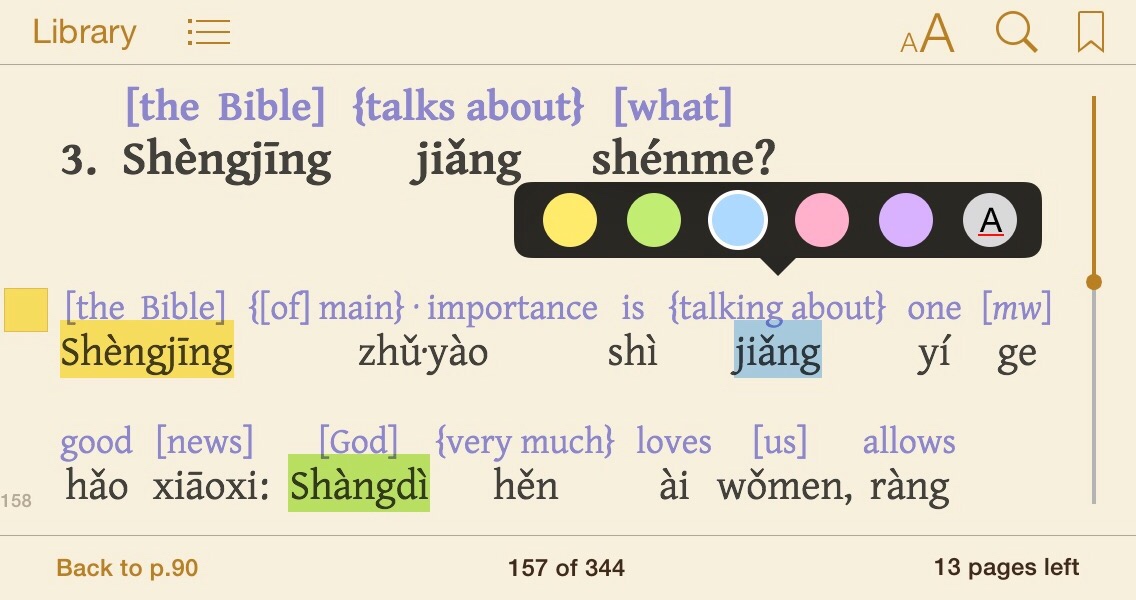
EPUB annotation in iBooks
Downloading and Opening EPUB Files
To download and open EPUB files on an iPhone or iPod touch:
- If the iBooks app is not already installed, go here to download and install it from the App Store.
- In Safari, tap on the desired EPUB file download link.
- After the EPUB file has finished downloading, tap on the Open in “iBooks” button that appears.
Using EPUB Files in iBooks
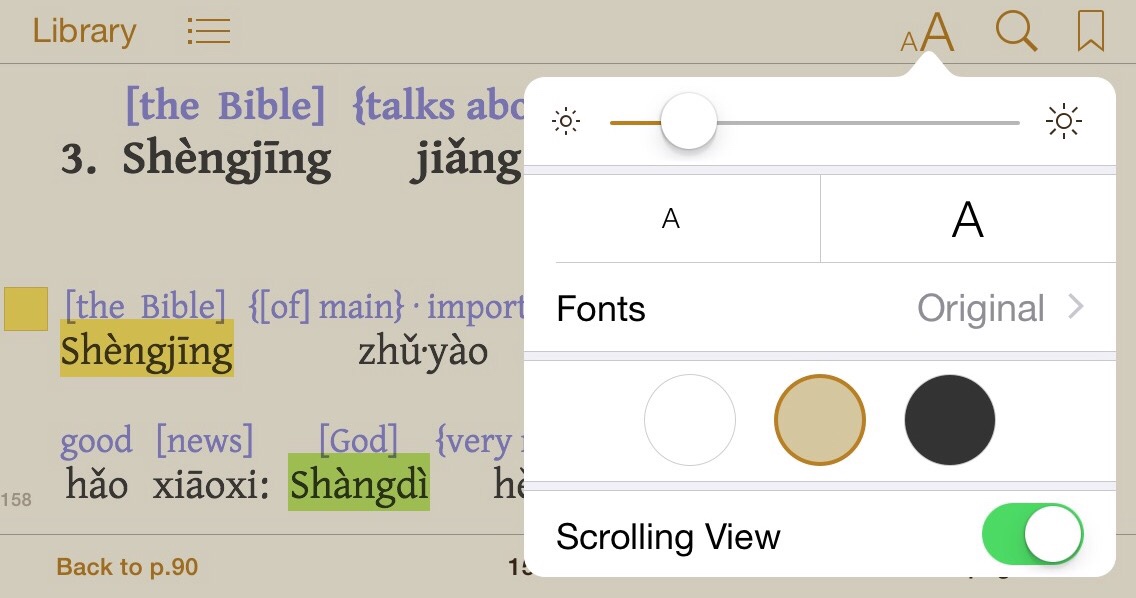
Selecting Scrolling View in iBooks
- iBooks must be running on iOS 6 or newer for it to be able to properly render the wordspacing.
- Go to the Settings app, iBooks section, and turn off Full Justification.
- In iBooks, use the Sepia or White theme to let the ruby text be shown in a different colour. (The Night theme changes all the text to be the same colour.)
- Using Scrolling View in landscape orientation is especially highly recommended.
The rest of this page will focus on using PDF files on the iPhone and iPod touch.
PDF Files and Paper Sizes
The “regular” 3-line, etc. PDF files, such as those named with “iPad-Letter-A4”, use A4/Letter as the paper size. The PDF files named with “XLP-iPhone-A5” have the same content as the corresponding iPad-Letter-A4 PDF files, but they use A5 as the paper size, resulting in the content appearing larger on-screen without requiring horizontal scrolling. The XLP-iPhone-A5 PDF files are especially suited for display on devices such as the iPhone, the iPod touch, and other devices with similarly sized screens, such as Android phones.
The XLP-iPhone-A5 PDF files should also be a good fit on 6" (15.2 cm) screen Kindles and other similarly sized devices, as well as on tablets with 7" (17.8 cm) screens, as long as these devices have PDF support. (Note that landscape orientation may work best, as explained below.) Some may prefer to use these files on larger mobile devices like the Kindle DX or the iPad as well.
Of course, while the XLP-iPhone-A5 files will be easier to read on mobile devices than the files that use A4/Letter as the paper size, the latter are able to fit more information onto each page—the XLP-iPhone-A5 PDF files just give you more options as you decide which text size/screen size/device orientation/file navigation ease combination works best for you.
Apps for PDF Files
While iBooks, Adobe Reader, and many other apps may be used to load and view the 3-line, etc. PDF files on your iPhone or iPod touch, I personally recommend using GoodReader because of its superior feature set, user experience, and performance.
Downloading PDF Files
To download a PDF file linked to on a web page on an iPhone or iPod touch using GoodReader:
- In Safari on your iPhone or iPod touch, tap and hold on the desired PDF file download link and tap the Copy button that appears.
- Switch to GoodReader for iPhone.
- Select the Web Downloads folder on the top level.
- Tap on Enter URL. The URL (web address) you just copied from Safari should have been automatically entered into the dialogue box that appears. If not, paste it there now. Tap the OK button.
- The file should get downloaded into the My Documents > Downloads folder. If you want to move it to another folder,
- tap the Actions button on the top right,
- tap the file to select it,
- tap the Move button,
- then navigate to your target folder and
- tap the Move 1 item here button on the lower right.
- Tap the Done button to return to the normal mode.
Orientation and Zooming
After loading a PDF for viewing on an iPhone or iPod touch, it is often best viewed in landscape orientation, in which the screen is widest in the horizontal dimension. To switch your iPhone or iPod touch to landscape orientation, turn it that way while making sure that what is then the top edge is farther from the ground than the bottom edge—if the device is kept flat relative to the ground, the switch to landscape orientation will not be triggered no matter how much you turn the device.
In GoodReader, you may also manually set and lock the orientation, as explained below.
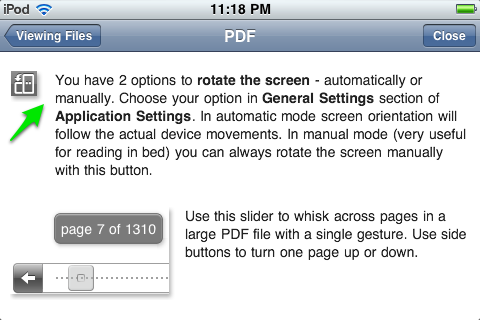
The next step is to zoom in (by pinching your fingers apart on the screen) and to scroll as needed so that a horizontal line of 3-line material fills the screen. With an XLP-iPhone-A5 PDF file, the material should now be at a size that is comfortable to read for someone with normal vision. Also, the material can now just be scrolled vertically (up and down), without requiring any horizontal (left and right) scrolling.
In GoodReader, you can use the Horizontal Scroll Lock button to cause the document to only scroll vertically and not horizontally.
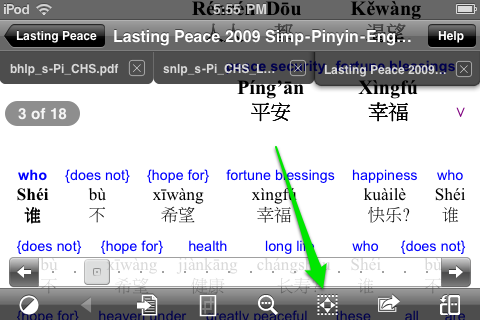
If you wish, you may zoom in further by pinching your fingers apart on the screen, or by double-tapping. Proper computer text in PDF files is rendered using mathematical formulas, not bitmaps, so the text will stay sharp even if you zoom in a lot. Doing so can help you get a better look at those little Pīnyīn diacritical tone marks, or those little strokes and dots that are critical components of Chinese characters.
PDF Link Navigation and Annotation
PDF bookmarks and links work like web hyperlinks, immediately taking you to the destination linked to when they are clicked or tapped on. This capability makes files much easier to navigate around in, especially on mobile devices such as the iPhone, the iPod touch, and the iPad. (See the PDF Link Navigation page for more information, including a video screen recording of the PDF bookmarks and links in action.)
GoodReader has good support for the PDF bookmarks and links used by the LinkNav and LN-A files. It even lets you add your own bookmarks. (Preexisting bookmarks may be listed in the Outlines section in the app.)
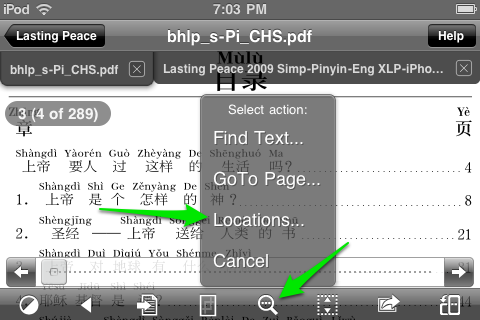
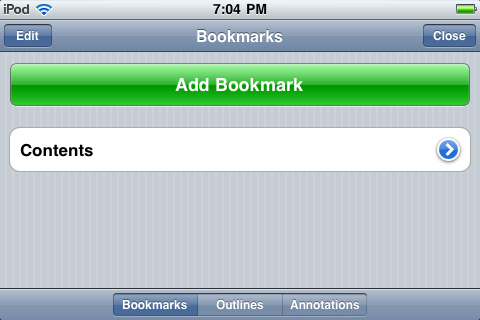
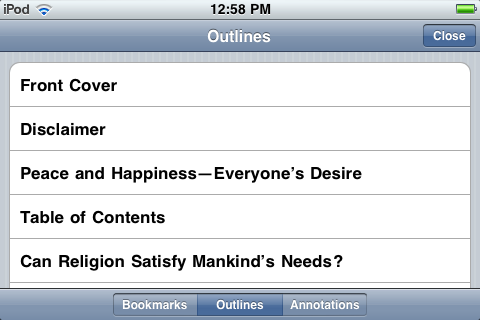
GoodReader also has good support for PDF annotation (notes & highlighting), which is enabled for desktop versions of Adobe Reader in the LN-A files. (Adobe Reader for iOS does not seem to need such special enabling.) PDF annotation is the ability to add notes or highlighting to PDFs, analogous to margin notes, underlining, etc. on paper printouts. (See the PDF Annotation (Notes & Highlighting) page for more information.)
Sharing PDF Files
You can easily take a 3-line, etc. PDF file that’s on your iPhone or iPod touch and share it with another person. Here are a few ways to do so:
- Direct the other person to the website from which the desired PDF file can be downloaded.
- In GoodReader, you may open the PDF file and email it to the other person, as shown below.
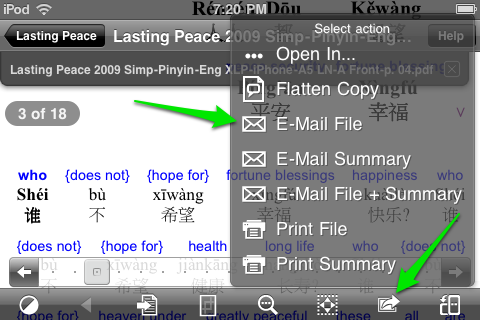
- In GoodReader running on iOS 7 or later, you can also use Apple’s AirDrop feature. To access this, just open the file and use the Open In… command shown above.
- For more information on how to set up and use AirDrop, go to this page on Apple’s website.